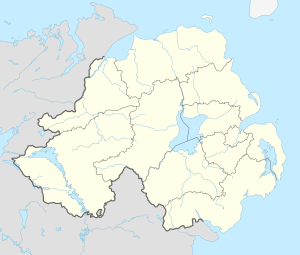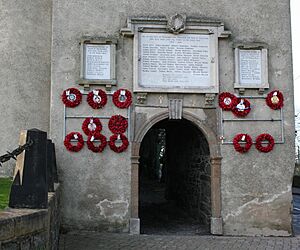Killyleagh Castle facts for kids
Quick facts for kids Killyleagh Castle |
|
|---|---|
| County Down, Northern Ireland in United Kingdom | |

Keep viewed from the gatehouse
|
|
|
Location within Northern Ireland
|
|
| Coordinates | 54°24′9″N 5°39′15″W / 54.40250°N 5.65417°W |
| Type | Castle |
| Site information | |
| Owner | Private |
| Open to the public |
Limited access |
| Site history | |
| In use | Late 12th century – present |
| Events | English Civil War |
Killyleagh Castle is a famous castle in the village of Killyleagh, County Down, Northern Ireland. It stands out in the small village and is thought to be the oldest castle in the country where people still live. Some parts of it date back to 1180!
The castle looks a bit like a fancy French castle, similar to those found in the Loire Valley. It was given a new look in the mid-1800s by a famous architect named Sir Charles Lanyon. The Hamilton family has owned Killyleagh Castle since the early 1600s.
Today, Killyleagh Castle is home to Gawn Rowan Hamilton and his family. Sometimes, the castle hosts concerts with famous musicians like Van Morrison. You can even stay in the castle's gate lodges for a holiday! From 2012 to 2014, the castle was also used as a filming location for the CBBC show, Dani's Castle.
Contents
Castle History
Early Days: 12th Century
Killyleagh was first settled in the 1100s by a Norman knight named John de Courcy. He built the first strong buildings on the castle's site in 1180. These were part of a group of forts around Strangford Lough. They helped protect the area from Viking attacks.
The Hamilton Family Arrives: 17th Century
In 1602, a powerful Irish leader named Con O'Neill owned a lot of land, including Killyleagh. After a fight, O'Neill was put in prison. His wife made a deal with a Scottish nobleman, Hugh Montgomery. She promised him half of O'Neill's lands if he could get the king to pardon O'Neill.
Montgomery got the pardon, but King James I decided to split the land into three parts. The area from Killyleagh to Bangor went to another Scot, James Hamilton. Around 1625, Hamilton moved into Killyleagh Castle and built the courtyard walls. The Hamilton family has lived there ever since.
Building and Battles
James Hamilton's son, James Hamilton, the first Earl of Clanbrassil, added a second tower to the castle. He supported King Charles I of England during the English Civil War. Because of this, Oliver Cromwell's forces attacked the castle in 1649. They sailed gunboats into Strangford Lough and blew up the gatehouse! The Earl had to escape, leaving his family behind. He was later fined to get his castle and land back.
The first Earl's son, Henry Hamilton, the second Earl of Clanbrassil, rebuilt the castle in 1666. He added the north tower and built a long, strong wall (called a bawn) in front of the castle. Most of the castle you see today was built during his time.
A Family Dispute
In 1667, the second Earl married Lady Alice Moore. Sadly, their only child died very young. Lady Alice found out that her father-in-law had written in his will that if Henry died without children, the castle would be split among five Hamilton cousins.
Lady Alice destroyed this will and had her husband write a new one in 1674, leaving everything to her. Henry died in 1675, and Lady Alice died in 1677, leaving the castle to her brother. However, the cousins knew about the original will and fought for their rights. After 20 years, a copy of the first Earl's will was found! By then, all the cousins had passed away.
The last cousin to die was James Hamilton. He had left the estate to be split between his daughter Anne and his younger brothers, Gawn and William Hamilton. In 1697, the court divided the castle. Gawn and William got the main house and towers, while their niece Anne received the bawn and gatehouse. This meant Gawn and William had to make a new entrance on the north side to get into their own castle!
Changes in the 18th and 19th Centuries
William died without children in 1716, and the castle then passed down through Gawn Hamilton's family. Gawn's great-grandson, Archibald Hamilton Rowan, who was an Irish nationalist, lived in the castle from 1806 to 1834 after returning from living in America.
Later, in 1850, Archibald Rowan-Hamilton and his wife hired the famous architect Sir Charles Lanyon to update the castle. Lanyon added turrets, giving the castle its beautiful, romantic look that we see today.
In 1860, another part of the Hamilton family, led by Frederick Temple Blackwood, gave the bawn and gatehouse back to the main Hamilton family. He then had a new gatehouse built to match the castle better.
20th Century Challenges
Killyleagh Castle faced attacks from the Irish Republican Army during the troubles in the 1920s. Gawn Rowan Hamilton shared a story from a newspaper that said his great-great uncle was woken up at 2 AM and exchanged gunfire from the castle walls! It sounds like a very exciting, though scary, time.
Castle Design
The design of Killyleagh Castle is quite unique. It doesn't look like a typical Irish tower house or castle.
Architect Benjamin Ferrey designed a grand gatehouse to match the two towers that were already there. Sir Charles Lanyon's impressive doorway was a way to celebrate the Rowan-Hamilton family finally being able to use their main front door again after almost 200 years!
Inside, the castle has beautiful, heavy plasterwork. The drawing room, dining room, and library are connected and look out onto the garden. Lanyon kept the special vaulted rooms in the northern round tower and the five-sided rooms in the other tower. He also covered the entire outside of the castle with new stone, while keeping the original windows. At the roof, he added many decorative turrets that look like candle snuffers.



